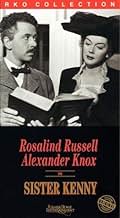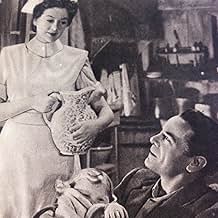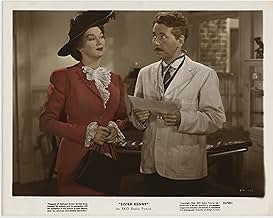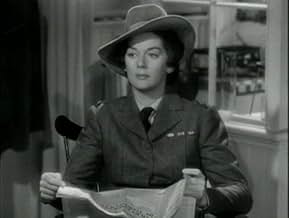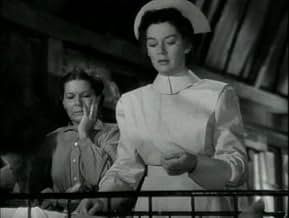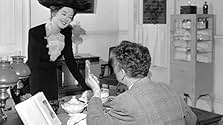Aggiungi una trama nella tua linguaAn Australian nurse, Sister Kenny, discovers an effective new treatment for infantile paralysis, but experiences great difficulty in convincing doctors of the validity of her claims.An Australian nurse, Sister Kenny, discovers an effective new treatment for infantile paralysis, but experiences great difficulty in convincing doctors of the validity of her claims.An Australian nurse, Sister Kenny, discovers an effective new treatment for infantile paralysis, but experiences great difficulty in convincing doctors of the validity of her claims.
- Regia
- Sceneggiatura
- Star
- Candidato a 1 Oscar
- 4 vittorie e 2 candidature totali
- Undetermined Minor Role
- (scene tagliate)
- Boy
- (scene tagliate)
- Minor Role
- (non citato nei titoli originali)
- Doctor
- (non citato nei titoli originali)
- Mr. Ferguson
- (non citato nei titoli originali)
- Doctor
- (non citato nei titoli originali)
- Doctor
- (non citato nei titoli originali)
Recensioni in evidenza
It has a strange idea of what Australia was like in the early 20th century. A bush dance is filled with Scots and Irish folk, and the music is bagpipes?! The accents are mostly British with the exception of the title role, which is played by Rosalind Russell, who has a distinctly American accent. Place names are mispronounced (like "Bris-bane" instead of "Bris-ban" for Brisbane).
And yet, there's a charm to this film. The real Elizabeth Kenny was an outsider who used unorthodox techniques and terminology to treat polio. It didn't cure the condition, but alleviated the symptoms. In the film she resolutely persists in practicing this and opposing the medical establishment, at a cost of her personal life.
Well worth watching.
The film chronicles the personal sacrifices Kenny made, giving up a chance at marriage, in order to help the children she encountered with polio and to try to convince the medical profession that her treatment was viable.
Rosalind Russell, whose nephew was helped by the Kenny Method, plays Sister Kenny, and she's wonderful. She ages during the film, but it's more than gray hair and some shadows drawn on the face - the age is in her walk, her attitude, and her carriage. A fantastic job that earned her an Oscar nomination.
Actor Alan Alda, opera star Marjorie Lawrence, and "Li'l Abner" creator Al Capp all were treated with the Kenny Method. Though the medical profession attempts to blow off alternative treatments, I've seen them work. This film is a reminder of the wall they put up, and one person's determination to break through it.
But no. Sister Kenny, knowing nothing about infantile paralysis, begins fiddling around with it in the Australian outback and develops a theory that is, in some senses, the exact opposite of the medical establishment's. That establishment is really "pig-headed", as she puts it. Well, they have to be, actually. The experts and their received wisdom can't be successfully challenged by a mere mortal. If they were, they wouldn't be "experts" anymore. She's successful, of course, or there would be no movie. All this takes place during the first half of the 20th century and has Sister Kenny traveling from Australia to Europe and to Minnesota. Old friends die. Children are apparently cured.
There are a couple of things that lift the film out of the ordinary biopic genre. One is Rosalind Russel's performance and the way her role is written by Dudley Nichols. She's impertinent and sarcastic. In fact she reminded me a lot of Margaret Mead, acerbic and distant, putting family life second to her career. Russel has never been better in what is a fairly demanding role.
Another point in its favor is that we are mercifully spared the sobbing and the dying and the children begging for help from a mothering figure. Russel is hardly maternal. Multiple opportunities for pointless and sentimental scenes were eschewed. Her humanity is on display in abundance but it's in code.
Nice job.
This is one of those biopics where the lead spends all her life struggling without realizing that she had been doing great work over a lifetime. These are uplifting sentimental fares and that's mostly what this movie is. Sister Kenny is a bit vinegary but not really. The biggest problem for me is the moniker Sister Kenny. I assumed that she was a nun. The movie should really explain that Australian terminology much earlier. I thought that I was missing something for most of the movie. Geez.
The film was interesting and a commentary on medical protectionism that has merit as a present day commentary regarding alternative medicine. The US government also issued a commemorative stamp in Sister Kenny's honor. It really did deserve the Golden Globe award for Rosalind Russell's acting.
Lo sapevi?
- QuizThe Wikipedia article on Elizabeth Kenny lists notable individuals who had been polio patients of Sister Kenny. Among those listed are Alan Alda, Dinah Shore, and Rosalind Russell's nephew. It is known that Rosalind Russell had long campaigned to portray Sister Kenny on film; her nephew's treatment might have been a factor in that interest.
- BlooperAlthough mostly set in Australia with primarily Australian characters, nobody in the cast attempts to speak in anything other than each's own native accent.
- Citazioni
Dr. McDonnell: Whatever you do, whatever happens, remember the people are more important than the system. That's true in government, they're fighting a war to prove it. And it's true in medicine. You've got that fight left Elizabeth. It's a big fight, it wont be easy, I wish I could help you.
- Colonne sonoreIt's a Long Way to Tipperary
(1912) (uncredited)
Written by Jack Judge and Harry Williams
Sung offscreen by a chorus of men
I più visti
- How long is Sister Kenny?Powered by Alexa
Dettagli
- Data di uscita
- Paese di origine
- Lingua
- Celebre anche come
- Todos son mis hijos
- Luoghi delle riprese
- Azienda produttrice
- Vedi altri crediti dell’azienda su IMDbPro
Botteghino
- Budget
- 1.200.000 USD (previsto)
- Tempo di esecuzione1 ora 56 minuti
- Colore
- Proporzioni
- 1.37 : 1

